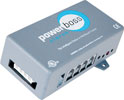Condensate free
January 2011
Sensors & Transducers

Somar’s Clarus is an energy saving refrigeration solution with a difference. It is an anti-sweat control system that reduces energy costs within retail refrigeration systems by controlling the use of the anti-sweat heaters for glass display doors, frames and mullions.
The patented moisture sensor technology automatically detects condensation and intelligently turns the heater on and off. Clarus typically delivers 60 to 80% reduction in anti-sweat heater on-time and additionally a 20% reduction in compressor run-time.
Many retail freezer or refrigeration systems have glass doors. Each has to be heated to keep condensation from forming on the glass to ensure that customers can clearly see the products that are being sold.
Typically, these heaters do not incorporate intelligence in their functionality as they are running all of the time and not just as required. These anti-sweat heaters are designed to operate 24/7 and can account for a significant portion of a store’s energy bill. Whether a retail food outlet has three to four display doors, or as many 100, there is scope for savings.
Clarus is easy to install and commission and no additional wiring is required. It meets UL, ULC and CE standards, and is lightweight with overall dimensions of 1390 x 63 x 825 mm.
For more information contact Mike Andrews, OEN Enterprises, +27 (0)11 675 4447, [email protected], www.oenenterprises.co.za
Further reading:
Adjustable proximity sensor with five metre range
Sensors & Transducers
The Telco line of photo-electric eyes have the accuracy and reliability you need.
Read more...
Food safety – a matter of weight
Sensors & Transducers
Weighing systems play a key role in ensuring product quality in food production, complying with legal requirements and avoiding product recalls. The Minebea Intec MiNexx portfolio has been specially developed to meet these requirements.
Read more...
Telco sensors in the paper and pulp industry
Sensors & Transducers
The paper and pulp industry poses a major problem for most photoelectric sensors. Telco Sensors has overcome this with its powerful and high-performance photoelectric sensors, ensuring penetration of thick and harsh pollution while guaranteeing reliable detection.
Read more...
Leaders in sensor technology
Sensors & Transducers
A new addition to the Telco Sensors range is the adjustable Proximity sensor, with a range up to 5 metres.
Read more...
Cutting-edge sensor technology
Endress+Hauser South Africa
Sensors & Transducers
The advantage of Endress+Hauser’s Memosens technology is that digitised measured values and sensor information are transmitted via a non-contact connection from the sensor to the cable, and as a digital signal to the transmitter.
Read more...
Miniature inductive sensors
ifm - South Africa
Sensors & Transducers
The inductive IY/IZ type sensors from ifm are used in various industrial areas where space is limited.
Read more...
The expanding role of 3D cameras in industrial quality control
TANDM Technologies
Sensors & Transducers
Across factory floors, warehouses, mines and research centres worldwide, computer vision paired with 3D camera technology is revolutionising quality control.
Read more...
PDS implementation on mines
Sensors & Transducers
Level 9 vehicle intervention for collision avoidance has been mandatory on South African mines since 2022, yet the effective roll-out of proximity detection systems remains slower than expected. This is not due to the technical limitations of integration but to operational readiness on site.
Read more...
Monitoring analogue process values
ifm - South Africa
Sensors & Transducers
Everywhere in industry, electronic sensors are used to detect process values such as temperature, pressure or flow. Process value monitoring often takes place directly in the sensor.
Read more...
Protecting buildings’ embodied carbon with retrofitted systems
Schneider Electric South Africa
Sensors & Transducers
The World Economic Forum has said that around 80% of the buildings in existence will still be around in 2050; it is therefore essential that in order to combat climate change we retrofit them for energy efficiency.
Read more...


